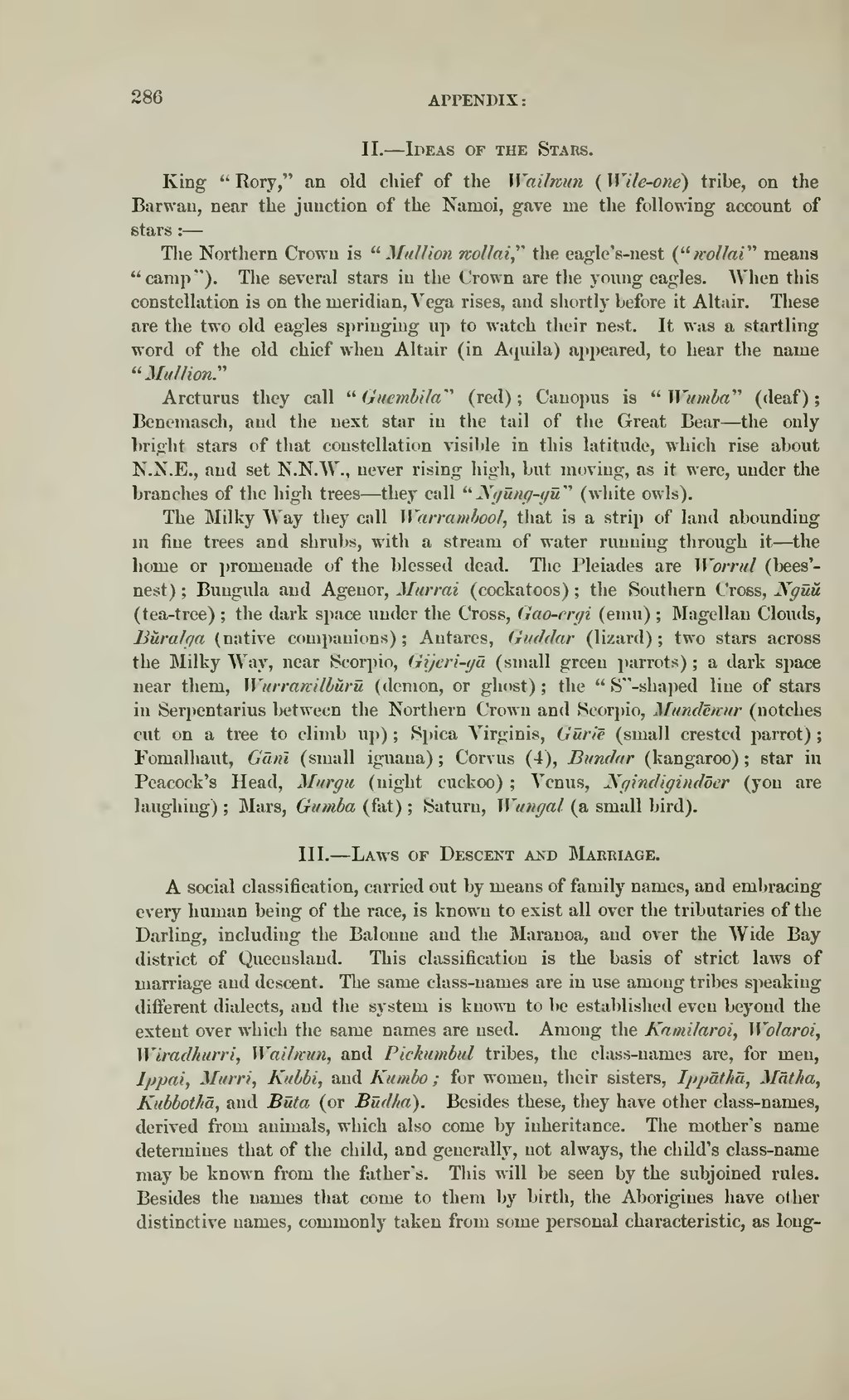II.—Ideas of the Stars.
King "Rory," an old chief of the Wailwun (Wile-one) tribe, on the Barwan, near the junction of the Namoi, gave me the following account of stars:—
Thee Northern Crown is "Mullion wollai," the eagle's-nest ("wollai" means "camp"). The several stars in the Crown are the young eagles. When this constellation is on the meridian, Vega rises, and shortly before it Altair. These are the two old eagles springing up to watch their nest. It was a startling word of the old chief when Altair (in Aquila) appeared, to hear the name "Mullion."
Arcturus they call "Guembila" (red); Canopus is "Wumba" (deaf); Benemasch, and the next star in the tail of the Great Bear—the only bright stars of that constellation visible in this latitude, which rise about N.N.E., and set N.N.W., never rising high, but moving, as it were, under the branches of the high trees—they call "Ngūng-gū" (white owls).
The Milky Way they call Warrambool, that is a strip of land abounding in fine trees and shrubs, with a stream of water running through it—the home or promenade of the blessed dead. The Pleiades are Worrul (bees'-nest); Bungula and Agenor, Murrai (cockatoos); the Southern Cross, Ngūǔ (tea-tree); the dark space under the Cross, Gao-ergi (emu); Magellan Clouds, Bǔralga (native companions); Antares, Guddar (lizard); two stars across the Milky Way, near Scorpio, Gijeri-gā (small green parrots); a dark space near them, Wurrawilbǔrū (demon, or ghost); the "S"-shaped line of stars in Serpentarius between the Northern Crown and Scorpio, Mundēwur (notches cut on a tree to climb up); Spica Virginis, Gūriē (small crested parrot); Fomalhaut, Gānī (small iguana); Corvus (4), Bundar (kangaroo); star in Peacock's Head, Murgu (night cuckoo); Venus, Ngindigindōer (you are laughing); Mars, Gumba (fat); Saturn, Wungal (a small bird).
III.—Laws of Descent and Marriage.
A social classification, carried out by means of family names, and embracing every human being of the race, is known to exist all over the tributaries of the Darling, including the Balonne and the Maranoa, and over the Wide Bay district of Queensland. This classification is the basis of strict laws of marriage and descent. The same class-names are in use among tribes speaking different dialects, and the system is known to be established even beyond the extent over which the same names are used. Among the Kamilaroi, Wolaroi, Wiradhurri, Wailwun, and Pickumbul tribes, the class-names are, for men, Ippai, Murri, Kubbi, and Kumbo; for women, their sisters, Ippāthā, Mātka, Kubbothā, and Būta (or Būdha). Besides these, they have other class-names, derived from animals, which also come by inheritance. The mother's name determines that of the child, and generally, not always, the child's class-name may be known from the father's. This will be seen by the subjoined rules. Besides the names that come to them by birth, the Aborigines have other distinctive names, commonly taken from some personal characteristic, as long-
